| FS class E.424 | |||||||||||||||||||||||||||
|---|---|---|---|---|---|---|---|---|---|---|---|---|---|---|---|---|---|---|---|---|---|---|---|---|---|---|---|
 A E.424N in Catania with the recent XMPR livery | |||||||||||||||||||||||||||
| |||||||||||||||||||||||||||
| |||||||||||||||||||||||||||
| |||||||||||||||||||||||||||
| |||||||||||||||||||||||||||
The FS E.424 is a class of Italian railways electric locomotives. They were built in 1943-1951 and have been decommissioned in 2008.
| FS class E.424 | |||||||||||||||||||||||||||
|---|---|---|---|---|---|---|---|---|---|---|---|---|---|---|---|---|---|---|---|---|---|---|---|---|---|---|---|
 A E.424N in Catania with the recent XMPR livery | |||||||||||||||||||||||||||
| |||||||||||||||||||||||||||
| |||||||||||||||||||||||||||
| |||||||||||||||||||||||||||
| |||||||||||||||||||||||||||
The FS E.424 is a class of Italian railways electric locomotives. They were built in 1943-1951 and have been decommissioned in 2008.
A design for a small multi-service Bo-Bo locomotive, with speed up to 90 km/h (56 mph), had been devised by Giuseppe Bianchi as early as in the 1930s, but the project had been halted by the introduction of the E.326 and E.428. After the realization of the 6-axle E.636, it was however decided to revamp the project by adapting to it some solutions already in use on the E.636 (engines, bogies, suspension etc.).
Breda SpA workshop provided the three prototypes of E.424 in 1943-1944. Mass production, however, could begin only after the end of World War II, part of the funds provided by the United Nations Relief and Rehabilitation Administration program.

The locomotives have been built in four series starting from 1943:

Class E.424, having DC type motors like all the Italian locomotives of the time, is a rheostatic-type locomotive; on start, a rheostat is connected in series to the motors and is gradually excluded as speed builds up allowing more current to flow to the motors; unlike other rheostatic locomotives of that time, this is not achieved via the characteristic lever (Maniglione), but through an automatic system, called Avviatore Automatico, derived from contemporary first-generation ALe 790/880/883 EMUs.
The driver simply selects the combination (series or parallel), and the relative rheostat contactors are automatically and gradually closed by this system; in case of failure, the driver can manually rotate an apposite wheel (that also usually rotates automatically as the system advances) to proceed with the exclusion.
When the rheostat is completely excluded for the series combination, field shunts can be inserted, or the driver can proceed to parallel combination, making a transition, which is handled by a device called "CEM" that automatically combines the motors (closing various contacts) accordingly.

Originally more than one unit could be coupled and be controlled remotely by the first locomotive using a system called Comando Multiplo; on the central part of the cab there also was a door that enabled the crew to pass from one locomotive to another in case of problems. However, because of safety issues and the imperfect reliability of this system (there were no instruments indicating the status of the slave locomotive, so it was not certain if it correctly made a transition or not, for example), it was abandoned and then disassembled.
Eleven units received compound-type motors, enabling a very fine speed control, in a range included between 25 and 50 km/h (16 and 31 mph) in series combination, and 50–100 km/h (31–62 mph) in parallel.
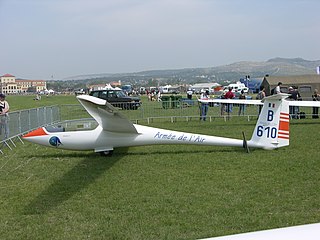
The Centrair C101 Pegase is a Standard Class single-seat glider manufactured by Centrair starting in 1981. The design uses the ASW 19 fuselage with a new wing designed by ONERA, giving better performance than the German original.

The FS E.645 and E.646 are two classes of similar electric locomotives used on Italian railways. They were introduced during the 1950s and they were retired in 2009.

The FS E.636 is a class of Italian articulated electric locomotives. They were introduced in the course of the 1940s until the 1960s, and have been decommissioned since 2006. They have been one of the most numerous Italian locomotive groups, and have been widely employed during their long career, hauling every type of train, ranging from freight to long range passenger services. Their introduction also saw the employment of some revolutionary design concepts, such as the articulated carbody and the three bogies scheme.

The class E 10 is an electric locomotive of the Deutsche Bundesbahn, introduced in 1952. It belongs to the Einheits-Elektrolokomotiven program and was built for express passenger service. In 1968 the series was redesignated as class 110 (E10) and class 112 (E10.12). In 1988 the last series of class 112 locomotives were designated as class 114, and in 1991 the remaining locomotives of class 112 were designated as class 113. In 2006 38 locomotives were designated as class 115.

The SZD-9 Bocian is a multi-purpose two-seat sailplane that was designed and built in Poland at Szybowcowy Zakład Doświadczalny in Bielsko-Biała, beginning in 1952. It was designed to be capable of fulfilling the needs of every area from training to competition flying.
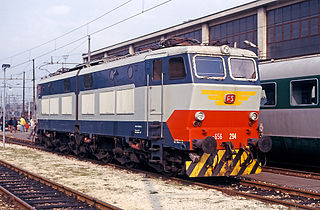
The Class E.656 is an Italian articulated rheostatic-type electric locomotive built from 1975 to 1989. An evolution of the E.646, they are mixed traffic locomotives, and have been used on every kind of train, ranging from freight to intercity passenger transport.

The FS E.444 is a class of Italian railways electric locomotives. They were introduced in the course of the 1960s until 1975. Starting from 1989, all E.444s were upgraded as E.444R.

The E.464 is a class of Italian railways electric locomotives. They were introduced in the course of the 1990s for hauling light trains, especially for commuter service. They were acquired by FS Trenitalia to replace the old E.424 and E.646, dating from the 1940s and 1950s. The class was originally designed by ABB Trazione, later ADTranz, and produced in the Italian plant of Vado Ligure.

The FS E.632 and E.633 are two classes of Italian railways electric locomotives. They were introduced in the course of the 1980s.

The FS E.625 and E.626 are two classes of Italian electric locomotives produced for the Ferrovie dello Stato. They were introduced in the course of the 1920s and remained in service until the 1990s. The E.626 was the first locomotive fed by 3,000 V DC overhead line in Italy.

The FS E.428 was a class of Italian railways electric locomotives. They were introduced in the course of the 1930s, for fast services on the Florence–Rome railway, being decommissioned in the 1980s.

The DR Class 243 is a universal electric locomotive of the Deutsche Reichsbahn which is used for general rail service. Deutsche Bahn lists the locomotive as Class 143. The locomotives of class 143/243 still belong to the most successful class of German electric locomotives.
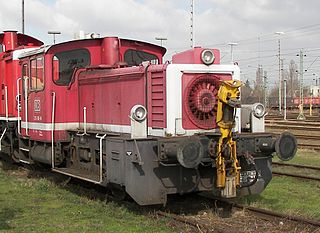
The DB railways Köf III class are light two axle shunting locomotives of Deutsche Bahn AG.

The Vossloh G1206 is a B'B' diesel hydraulic freight locomotive built in Kiel and used by several European railway operators including a SNCF specific variant the BB 461000 series.

The FS Class E.431 was a class of three-phase AC electric locomotives of the Italian State Railways (FS).

FS Class E.432 was a class of three-phase electric locomotives of the Italian State Railways. Forty of these 1′D1′ locomotives were built in 1928 by Società Ernesto Breda and two have been preserved.
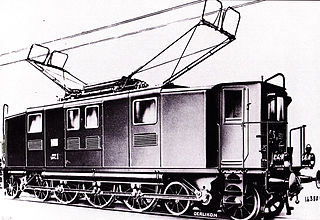
FS Class E.332 was a class of three-phase electric locomotives of the Italian State Railways (FS). They were used for the haulage of passenger trains between 1917 and 1963. Designed and built at the same time as the FS Class E.331, they represented an attempt by FS to extend the use of three-phase AC electric traction from primary to secondary routes. Their performance was disappointing and they were relegated to a marginal role, in which they remained despite several modifications.

FS Class E.333 was a class of electric locomotives of the Ferrovie dello Stato (FS), powered by three-phase alternating current, which were in service from 1923 to 1968. They were designed by Kálmán Kandó for hauling fast passenger trains. Having the same electrical equipment as the FS Class E.552 locomotives, they presented the same defects and had to be modified. After modification, they were able to carry out the services for which they were designed.
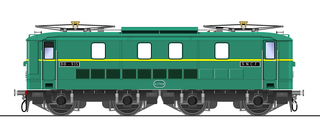
The SNCF Class BB 900 was a class of 35 mixed-traffic electric locomotives built between 1936 and 1937 for État. The class was a development of the pre-war Midi Class E4700 and very similar to the later Class BB 300 and Class BB 325. Initial use was on the Paris–Le Mans line. The class was withdrawn in 1987 after 50 years in service.

The E.323 locomotives and E.324 motor trailers were two sets of 3000 V direct current electric locomotives of the Italian State Railways (FS) used for shunting service in large rail yards and in embarking and disembarking from ferries.